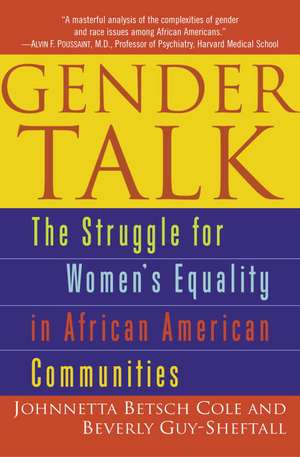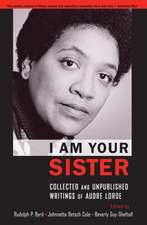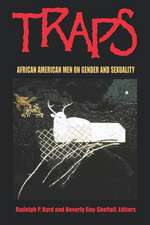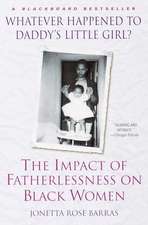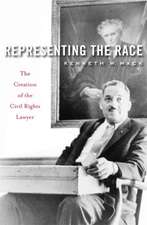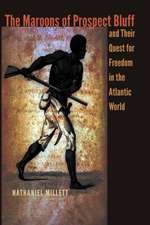Gender Talk: The Struggle for Women's Equality in African American Communities
Autor Johnnetta B. Cole, Beverly Guy Sheftall, Beverly Guy-Sheftallen Limba Engleză Paperback – 30 noi 2003
Examining why the “race problem” has become so male-centered and how this has opened a deep divide between Black women and men, the authors turn to their own lives, offering intimate accounts of their experiences as daughters, wives, and leaders. They examine pivotal moments in African American history when race and gender issues collided with explosive results. Along the way, they present the testimonies of a large and influential group of Black women and men, including Byllye Avery, Derrick A. Bell, Farai Chideya, Kimberlé Crenshaw, Michael Eric Dyson, Marcia Gillespie, bell hooks, and Faye Wattleton. Fearless and eye-opening, Gender Talk is required reading for anyone concerned with the future of African American women—and men.
Preț: 133.62 lei
Nou
Puncte Express: 200
Preț estimativ în valută:
25.57€ • 26.52$ • 21.32£
25.57€ • 26.52$ • 21.32£
Carte disponibilă
Livrare economică 06-20 martie
Preluare comenzi: 021 569.72.76
Specificații
ISBN-13: 9780345454133
ISBN-10: 0345454138
Pagini: 336
Dimensiuni: 140 x 208 x 20 mm
Greutate: 0.27 kg
Ediția:Trade Pbk.
Editura: One World/Ballantine
ISBN-10: 0345454138
Pagini: 336
Dimensiuni: 140 x 208 x 20 mm
Greutate: 0.27 kg
Ediția:Trade Pbk.
Editura: One World/Ballantine
Notă biografică
Johnnetta Betsch Cole is the President of Bennett College in Greensboro, North Carolina. She is President emerita of Spelman College and Professor emerita of anthropology, Women’s Studies, and African American Studies at Emory University. A nationally known African American feminist-intellectual, she is the author of several books, including Conversations: Straight Talk with America’s Sister President.
Beverly Guy-Sheftall is the Anna Julia Cooper Professor of Women’s Studies and English, and the Director of the Women’s Research and Resource Center at Spelman College. She is the editor of Words of Fire: An Anthology of African American Feminist Thought and coeditor (With Rudolph Byrd) of Traps: African American Men on Gender and Sexuality among many other publications. She lives in Atlanta.
From the Hardcover edition.
Beverly Guy-Sheftall is the Anna Julia Cooper Professor of Women’s Studies and English, and the Director of the Women’s Research and Resource Center at Spelman College. She is the editor of Words of Fire: An Anthology of African American Feminist Thought and coeditor (With Rudolph Byrd) of Traps: African American Men on Gender and Sexuality among many other publications. She lives in Atlanta.
From the Hardcover edition.
Extras
The personal is politica. You can’t know where you’re going if you don’t know where you’ve been. African proverb
Growing up in the fifties, I never thought much about the issue of gender; race was too overwhelming. Leith Mullings, On Our Own Terms: Race, Class, and Gender in the Lives of African American Women, 1997
We are actively committed to struggling against racial, sexual, heterosexual, and class oppression, and see as our particular task the development of integrated analysis and practice based upon the fact that the major systems of oppression are interlocking. Combahee River Collective, 1983
When we finally met in 1987 at Hunter College in New York City, it seemed like a long overdue meeting. We knew a great deal about each other and had read each other’s work. We also knew that we viewed gender differently from many African American men and women who ignored, trivialized, or denied its significance. The question we pose here is why? In particular, we wanted to explore those factors in our own lives that significantly influenced our gender attitudes. How did we come to the conclusion that in order to understand Black America we must confront how deeply race matters—but also how gender matters—and how both race and gender intersect in the lives of women and men, girls and boys?
In this autobiographical chapter we describe pivotal moments in our own personal histories, which shaped our perspectives on gender and led us to call ourselves Black feminists and to work in the women’s movement. We believe that our own stories, like the stories of the men and women whose lives we share in Chapter 2, “Having Their Say: Conversations with Brothers and Sisters,” can help illuminate some of the themes that emerge in subsequent chapters. Over the course of our evolving friendship, we began to realize how similar many of our experiences had been, though there were also many differences; Johnnetta’s coming of age in the fifties and Beverly’s coming of age in the sixties was a major factor in this regard. But our respective journeys to feminism had begun in similar places. We begin, therefore, with our family backgrounds and the influence of our mothers in particular. We probe how we came to have certain views on religion, sexuality, homophobia, and interpersonal relationships, especially marriage and friendships. We articulate the circumstances under which we came to ally ourselves with African American Studies and Women’s Studies and the nature of our activism around race and gender issues. And we give voice to painful personal experiences that connect us to what countless women—including Black women—have endured because of the reign of patriarchy in American society and throughout the world. Examining certain aspects of our lives underscored for us once again how the personal is indeed political.
We begin this chapter with a reminder of what U.S. women’s struggles over the past forty years have been about, despite the ways in which they’ve been trivialized:
They started women’s shelters; they changed how the police interview rape survivors. They deeply reformed birthing and other health practices. They demanded control of their bodies in all kinds of different situations—in sex, in reproduction, on the street, and at work. They put preschool child care on the national agenda. They criticized images everywhere . . . They were interested in making divorce no-fault and marriage rather better . . . They fought for the participation of women and girls in sports. They struggled for expansion of female opportunities in the workforce. They proposed equal pay for jobs of comparable worth. . . . They recovered the biographies, issues, and works of under-appreciated women once active in history and culture. They worked for family leave for birth and adoption.1
The women’s movement also created a climate in which women, perhaps for the first time in large numbers, could choose whether they would marry or become mothers. Certainly we have both witnessed and experienced the positive transformations brought about by the women’s movement. We are also aware of how few African American women’s voices there are in the voluminous literature on the history and impact of the women’s movement. This erasure of Black women in popular and scholarly histories, television documentaries, and magazine articles in retrospectives about the “second-wave” women’s liberation movement perpetuates the myth that we were absent from the development of contemporary feminism rather than being critical to its formulations.2 Three African American women—Shirley Chisholm, Pauli Murray, attorney and member of President Kennedy’s Commission on the Status of Women, 1961–1963, and Aileen Hernandez, union organizer and second president of the National Organization of Women (NOW)—were involved with twenty-six other women in the creation of the mostly white feminist organization NOW in 1966.
Black feminists were especially insightful about the connections between race and gender and how differences between women made it difficult for them to bond on the basis of their common womanhood. Even more scarce are the voices of Native American, Chicana/Latina, Asian American and Arab American women in these narratives. Ignoring or devaluing the unique and often oppositional perspectives of women of color during the Movement, it is not surprising that mainstream feminists would “white-out,” marginalize, or even forget these contributions in reconstructions of “their” Movement some years later. Despite these silences, however, the promise of feminism—that women can live better lives with a wider range of choices and resources—is in fact a reality four decades after the beginning of the “second wave” of the women’s movement. It has enabled women and girls, even those victimized by poverty and racism, to inhabit a world different from the worlds of our grandmothers and great-grandmothers. This is not to suggest, however, that profound differences do not continue to be a reality among women with respect to our experiences, choices, resources, and life chances.
Our decision to discuss very personal aspects of our respective lives is very much a reflection of a proposition that is closely associated with the “second wave” of the women’s movement—“the personal is political.” In the late 1960s and early 1970s small groups of radical women involved in the development of feminist organizations gathered together in meetings and shared their personal stories of being female and oppressed. In these “consciousness-raising” sessions, described as the movement’s most effective organizing tool, the details of one’s particular story were echoed in the story of another woman, and another, and another.3 While this term has been attributed to feminist activist Kathie Sarachild, a member of New York Radical Women, she acknowledges that she learned the practice of “telling it like it is” during her involvement with the Student Nonviolent Coordinating Committee (SNCC) in the civil rights movement in Mississippi.4 What became clear fairly soon in analyses of male supremacy was that what an individual woman had assumed was peculiar to her was in reality a rather common experience in the lives of women. What was assumed to be personal was in fact generalizable, and could therefore be acted upon in an organized and collective way. In short, the personal was seen to be political.4
These consciousness-raising sessions were intended to foster sisterhood among women who named their common enemies and bonded on the basis of their common oppressions. Women’s movement scholars have tended to assume that these sessions took place primarily among middle-class white women who did not work outside their homes, and therefore had the luxury of sitting around talking and drinking coffee after they had taken their children to school. This image of privileged, unemployed white women—the stereotypical vanguard of the newly emerging women’s liberation movement—needs to be challenged, however, because both middle- and working-class Black women also gathered around kitchen tables and elsewhere and discovered commonalities with women both different from and like themselves. Less economically privileged Black women also made similar discoveries about their collective plight during coffee breaks at their factory jobs, sitting in Laundromats waiting for their families clothes to dry, and in church basements as they fried chicken and made potato salad for the annual church picnic. It is also important to note that consciousness-raising was an important strategy of Black feminist organizations, including the little known National Black Feminist Organization (NBFO) which began in May 1973 when about thirty Black women gathered in New York for a day-long meeting to discuss their experiences. Six months later they convened the first national conference of Black feminists in New York City; the organization was interested in exposing media stereotypes and the sexual abuse and rape of Black women, and securing the minimum wage for domestic workers, as well as underscoring the need of the Black and women’s communities to address both racism and sexism simultaneously.5 Among its five hundred attendees were Shirley Chisholm, Eleanor Holmes Norton, Flo Kennedy, Barbara Smith, Alice Walker, Michele Wallace, and Margaret Sloan, its first and only president.
An acknowledgment that the personal is political was a dramatic departure from what most men and many women had been thinking or saying. For most men, especially middle-class white men, the world was neatly dichotomized into the private (women’s spheres) and the public (men’s spheres). The personal (women’s domain) and the political (the public arena of power and action) were disconnected. For many women, there was an outward accommodation to this bifurcated view of the world, although many of their experiences suggested something very different.
Each of us also participated in “consciousness-raising” sessions and came to see multiple ways in which we were connected to other women. In 1968, when Beverly was a graduate student at Atlanta University studying literature, she was one of a small group of young Black women who met on Sunday afternoons at Sandra Flowers’s small apartment in a working-class neighborhood near the campus. Beverly came to realize much later that these were consciousness-raising sessions. In the late 1960s and early 70s, Johnnetta was involved in periodic gatherings with women in the university town of Pullman, Washington, where common and different experiences with gender matters were discussed and debated.
Though our lives took divergent paths and ten years separate us in age, each of us grew up largely in the separate world of Black people in the Deep South. Johnnetta was born in 1936 in Jacksonville, Florida, and Beverly was born in 1946 in Memphis, Tennessee. We each grew up with two siblings (Beverly is the oldest of three daughters, and Johnnetta has an older sister and a younger brother); in two-parent households (until Beverly was eleven and her parents separated, and Johnnetta was fifteen and her father died); in middle- and upper-middle-class extended families. After Beverly’s parents separated, her mother moved with her three daughters around the corner to her parents’ home. Beverly’s grandfather was a Baptist minister and her grandmother a stay-at-home mother. Johnnetta did not live with her grandparents, but her grandfather and his second wife were very much a part of her early life; and into her young adulthood, her grandfather was a central figure in her life. This was also the case with her great-grandfather until he died when Johnnetta was eleven years old.
In the South of the 1940s and 50s, every aspect of our public lives was defined by the socially constructed notion of “race.” Being Black determined where one sat on a bus or at the movies, from which water fountain one drank, on which day one went to the zoo or circus, in which cemetery one was buried, where one attended school, worshiped, or played. Class could soften some of the persistent inequities and painful humiliations that African Americans endured in the apartheid South before the civil rights movement, but no amount of money would enable Black people to fully escape the indignities of Jim Crow. Although Johnnetta’s maternal great-grandfather was Abraham Lincoln Lewis, Jacksonville’s first Black millionaire, he was unable to shield his family from racism. His material wealth and prestige and the resources of her middle-class nuclear family spared Johnnetta some of the most egregious consequences of being Black in Jacksonville—she could travel by car and avoid the back of the bus—but there was no way around attending “colored” schools and no way to gain entrance to “for whites only” concerts, art galleries, and theaters. To be sure, each of us at an early age was conscious of the racially stratified society in which we were living and we barely noticed the highly gendered rules of the Jim Crow South. Later, when Beverly arrived at Spelman College in Atlanta, Georgia, in 1962, she did notice how different the rules governing the lives of women students were from the rules for the male students at Morehouse. Spelman women were subjected to rigid curfews and dress codes that were absent at their nearby brother institution, Morehouse College.
From the Hardcover edition.
Growing up in the fifties, I never thought much about the issue of gender; race was too overwhelming. Leith Mullings, On Our Own Terms: Race, Class, and Gender in the Lives of African American Women, 1997
We are actively committed to struggling against racial, sexual, heterosexual, and class oppression, and see as our particular task the development of integrated analysis and practice based upon the fact that the major systems of oppression are interlocking. Combahee River Collective, 1983
When we finally met in 1987 at Hunter College in New York City, it seemed like a long overdue meeting. We knew a great deal about each other and had read each other’s work. We also knew that we viewed gender differently from many African American men and women who ignored, trivialized, or denied its significance. The question we pose here is why? In particular, we wanted to explore those factors in our own lives that significantly influenced our gender attitudes. How did we come to the conclusion that in order to understand Black America we must confront how deeply race matters—but also how gender matters—and how both race and gender intersect in the lives of women and men, girls and boys?
In this autobiographical chapter we describe pivotal moments in our own personal histories, which shaped our perspectives on gender and led us to call ourselves Black feminists and to work in the women’s movement. We believe that our own stories, like the stories of the men and women whose lives we share in Chapter 2, “Having Their Say: Conversations with Brothers and Sisters,” can help illuminate some of the themes that emerge in subsequent chapters. Over the course of our evolving friendship, we began to realize how similar many of our experiences had been, though there were also many differences; Johnnetta’s coming of age in the fifties and Beverly’s coming of age in the sixties was a major factor in this regard. But our respective journeys to feminism had begun in similar places. We begin, therefore, with our family backgrounds and the influence of our mothers in particular. We probe how we came to have certain views on religion, sexuality, homophobia, and interpersonal relationships, especially marriage and friendships. We articulate the circumstances under which we came to ally ourselves with African American Studies and Women’s Studies and the nature of our activism around race and gender issues. And we give voice to painful personal experiences that connect us to what countless women—including Black women—have endured because of the reign of patriarchy in American society and throughout the world. Examining certain aspects of our lives underscored for us once again how the personal is indeed political.
We begin this chapter with a reminder of what U.S. women’s struggles over the past forty years have been about, despite the ways in which they’ve been trivialized:
They started women’s shelters; they changed how the police interview rape survivors. They deeply reformed birthing and other health practices. They demanded control of their bodies in all kinds of different situations—in sex, in reproduction, on the street, and at work. They put preschool child care on the national agenda. They criticized images everywhere . . . They were interested in making divorce no-fault and marriage rather better . . . They fought for the participation of women and girls in sports. They struggled for expansion of female opportunities in the workforce. They proposed equal pay for jobs of comparable worth. . . . They recovered the biographies, issues, and works of under-appreciated women once active in history and culture. They worked for family leave for birth and adoption.1
The women’s movement also created a climate in which women, perhaps for the first time in large numbers, could choose whether they would marry or become mothers. Certainly we have both witnessed and experienced the positive transformations brought about by the women’s movement. We are also aware of how few African American women’s voices there are in the voluminous literature on the history and impact of the women’s movement. This erasure of Black women in popular and scholarly histories, television documentaries, and magazine articles in retrospectives about the “second-wave” women’s liberation movement perpetuates the myth that we were absent from the development of contemporary feminism rather than being critical to its formulations.2 Three African American women—Shirley Chisholm, Pauli Murray, attorney and member of President Kennedy’s Commission on the Status of Women, 1961–1963, and Aileen Hernandez, union organizer and second president of the National Organization of Women (NOW)—were involved with twenty-six other women in the creation of the mostly white feminist organization NOW in 1966.
Black feminists were especially insightful about the connections between race and gender and how differences between women made it difficult for them to bond on the basis of their common womanhood. Even more scarce are the voices of Native American, Chicana/Latina, Asian American and Arab American women in these narratives. Ignoring or devaluing the unique and often oppositional perspectives of women of color during the Movement, it is not surprising that mainstream feminists would “white-out,” marginalize, or even forget these contributions in reconstructions of “their” Movement some years later. Despite these silences, however, the promise of feminism—that women can live better lives with a wider range of choices and resources—is in fact a reality four decades after the beginning of the “second wave” of the women’s movement. It has enabled women and girls, even those victimized by poverty and racism, to inhabit a world different from the worlds of our grandmothers and great-grandmothers. This is not to suggest, however, that profound differences do not continue to be a reality among women with respect to our experiences, choices, resources, and life chances.
Our decision to discuss very personal aspects of our respective lives is very much a reflection of a proposition that is closely associated with the “second wave” of the women’s movement—“the personal is political.” In the late 1960s and early 1970s small groups of radical women involved in the development of feminist organizations gathered together in meetings and shared their personal stories of being female and oppressed. In these “consciousness-raising” sessions, described as the movement’s most effective organizing tool, the details of one’s particular story were echoed in the story of another woman, and another, and another.3 While this term has been attributed to feminist activist Kathie Sarachild, a member of New York Radical Women, she acknowledges that she learned the practice of “telling it like it is” during her involvement with the Student Nonviolent Coordinating Committee (SNCC) in the civil rights movement in Mississippi.4 What became clear fairly soon in analyses of male supremacy was that what an individual woman had assumed was peculiar to her was in reality a rather common experience in the lives of women. What was assumed to be personal was in fact generalizable, and could therefore be acted upon in an organized and collective way. In short, the personal was seen to be political.4
These consciousness-raising sessions were intended to foster sisterhood among women who named their common enemies and bonded on the basis of their common oppressions. Women’s movement scholars have tended to assume that these sessions took place primarily among middle-class white women who did not work outside their homes, and therefore had the luxury of sitting around talking and drinking coffee after they had taken their children to school. This image of privileged, unemployed white women—the stereotypical vanguard of the newly emerging women’s liberation movement—needs to be challenged, however, because both middle- and working-class Black women also gathered around kitchen tables and elsewhere and discovered commonalities with women both different from and like themselves. Less economically privileged Black women also made similar discoveries about their collective plight during coffee breaks at their factory jobs, sitting in Laundromats waiting for their families clothes to dry, and in church basements as they fried chicken and made potato salad for the annual church picnic. It is also important to note that consciousness-raising was an important strategy of Black feminist organizations, including the little known National Black Feminist Organization (NBFO) which began in May 1973 when about thirty Black women gathered in New York for a day-long meeting to discuss their experiences. Six months later they convened the first national conference of Black feminists in New York City; the organization was interested in exposing media stereotypes and the sexual abuse and rape of Black women, and securing the minimum wage for domestic workers, as well as underscoring the need of the Black and women’s communities to address both racism and sexism simultaneously.5 Among its five hundred attendees were Shirley Chisholm, Eleanor Holmes Norton, Flo Kennedy, Barbara Smith, Alice Walker, Michele Wallace, and Margaret Sloan, its first and only president.
An acknowledgment that the personal is political was a dramatic departure from what most men and many women had been thinking or saying. For most men, especially middle-class white men, the world was neatly dichotomized into the private (women’s spheres) and the public (men’s spheres). The personal (women’s domain) and the political (the public arena of power and action) were disconnected. For many women, there was an outward accommodation to this bifurcated view of the world, although many of their experiences suggested something very different.
Each of us also participated in “consciousness-raising” sessions and came to see multiple ways in which we were connected to other women. In 1968, when Beverly was a graduate student at Atlanta University studying literature, she was one of a small group of young Black women who met on Sunday afternoons at Sandra Flowers’s small apartment in a working-class neighborhood near the campus. Beverly came to realize much later that these were consciousness-raising sessions. In the late 1960s and early 70s, Johnnetta was involved in periodic gatherings with women in the university town of Pullman, Washington, where common and different experiences with gender matters were discussed and debated.
Though our lives took divergent paths and ten years separate us in age, each of us grew up largely in the separate world of Black people in the Deep South. Johnnetta was born in 1936 in Jacksonville, Florida, and Beverly was born in 1946 in Memphis, Tennessee. We each grew up with two siblings (Beverly is the oldest of three daughters, and Johnnetta has an older sister and a younger brother); in two-parent households (until Beverly was eleven and her parents separated, and Johnnetta was fifteen and her father died); in middle- and upper-middle-class extended families. After Beverly’s parents separated, her mother moved with her three daughters around the corner to her parents’ home. Beverly’s grandfather was a Baptist minister and her grandmother a stay-at-home mother. Johnnetta did not live with her grandparents, but her grandfather and his second wife were very much a part of her early life; and into her young adulthood, her grandfather was a central figure in her life. This was also the case with her great-grandfather until he died when Johnnetta was eleven years old.
In the South of the 1940s and 50s, every aspect of our public lives was defined by the socially constructed notion of “race.” Being Black determined where one sat on a bus or at the movies, from which water fountain one drank, on which day one went to the zoo or circus, in which cemetery one was buried, where one attended school, worshiped, or played. Class could soften some of the persistent inequities and painful humiliations that African Americans endured in the apartheid South before the civil rights movement, but no amount of money would enable Black people to fully escape the indignities of Jim Crow. Although Johnnetta’s maternal great-grandfather was Abraham Lincoln Lewis, Jacksonville’s first Black millionaire, he was unable to shield his family from racism. His material wealth and prestige and the resources of her middle-class nuclear family spared Johnnetta some of the most egregious consequences of being Black in Jacksonville—she could travel by car and avoid the back of the bus—but there was no way around attending “colored” schools and no way to gain entrance to “for whites only” concerts, art galleries, and theaters. To be sure, each of us at an early age was conscious of the racially stratified society in which we were living and we barely noticed the highly gendered rules of the Jim Crow South. Later, when Beverly arrived at Spelman College in Atlanta, Georgia, in 1962, she did notice how different the rules governing the lives of women students were from the rules for the male students at Morehouse. Spelman women were subjected to rigid curfews and dress codes that were absent at their nearby brother institution, Morehouse College.
From the Hardcover edition.
Recenzii
“A groundbreaking look at the controversial topic of sexism and gender politics within African American communities.”
—Ebony
“CAPTIVATING, BOLD, AND WELL RESEARCHED . . . A book of such breadth and insight . . . The strength of Gender Talk lies not only in its rich content and in its persuasive claims about the role of gender and sexuality in the struggle against racism, but also in the ease with which it wears its learning.”
—The Crisis Forum
“An easy read on a complex topic . . . Johnetta Betsch Cole and Beverly Guy-Sheftall bravely question and discuss gender politics and re-illuminate the gender matters of Black life.”
—Upscale magazine
“A masterful analysis of the complexities of gender and race issues among African Americans.”
—ALVIN F. POUSSAINT, M.D.
Professor of Psychiatry
Harvard Medical School
“PERSONALLY HONEST, WELL-RESEARCHED, PRACTICAL, AND BRAVE . . .
Johnnetta Cole and Beverly Guy-Sheftall have given all Americans a healing book that no family, classroom, library, or couple should be without.”
—GLORIA STEINEM
“Back in the day, Black people agreed not to talk about women’s liberation. . . . Cole and Guy-Sheftall have done us all a service in calling us to finish the work of women’s equity in our community. This book should be read by everyone interested in the welfare of women and of Black people.”
—MINDY FULLILOVE, Professor of
Clinical Psychiatry and Public Health
Columbia University
“Truth telling, wisdom sharing, strong women have been and are the ‘tie that binds the Black Community.’ This book by two sisters in that long line is filled with truth and wisdom.”
—THE REV. CANON FREDERICK B. WILLIAMS
Rector, Church of the Intercession
Harlem, New York
FRONT SALES I (cont’d)GENDER TALKSPRING 2004 (TR)
“Every feminist—and everyone who cares about racial and gender justice— should read Gender Talk to understand the deep connections between these historic liberation movements. . . . This book is an original contribution to the political dialogue about race and sex.”
—ESTELLE FREEDMAN
Department of History, Stanford University
Author of No Turning Back
“THOUGHTFUL, PROVOCATIVE, CONCERNED, AND URGENT,
this work ignites a much-needed debate over the state of true Black community and the role of women within that community. . . .
Historically centered and respectful.”
—Publishers Weekly
“Gender Talk reaches not for what is safe and easy, but for the most difficult issues that will confront Black women and men in the years ahead if they are to survive as a group. . . . Written from the heads and the hearts of two women with long careers in race and gender struggles inside and across the color line, its brilliant but blunt honesty speaks truth through the power of Black womanhood.”
—NELLIE Y. MCKAY
Department of African American Studies
University of Wisconsin, Madison
“Recommended . . . A down-to-earth, unabashedly revolutionary corrective to the conservative slant of much that is published regarding African American communities.”
—Library Journal
“This is an impassioned, insightful look at a controversial topic.”
—Booklist
“Gender Talk challenges the zero/sum game of patriarchy—that women must lose so men can win—with the simple truth that the Black community only wins when all its members are strong. Personally honest, well-researched, practical and brave, Johnnetta Cole and Beverly Guy-Sheftall have given all Americans a healing book that no family, classroom, library, or couple should be without.”
—GLORIA STEINEM
—Ebony
“CAPTIVATING, BOLD, AND WELL RESEARCHED . . . A book of such breadth and insight . . . The strength of Gender Talk lies not only in its rich content and in its persuasive claims about the role of gender and sexuality in the struggle against racism, but also in the ease with which it wears its learning.”
—The Crisis Forum
“An easy read on a complex topic . . . Johnetta Betsch Cole and Beverly Guy-Sheftall bravely question and discuss gender politics and re-illuminate the gender matters of Black life.”
—Upscale magazine
“A masterful analysis of the complexities of gender and race issues among African Americans.”
—ALVIN F. POUSSAINT, M.D.
Professor of Psychiatry
Harvard Medical School
“PERSONALLY HONEST, WELL-RESEARCHED, PRACTICAL, AND BRAVE . . .
Johnnetta Cole and Beverly Guy-Sheftall have given all Americans a healing book that no family, classroom, library, or couple should be without.”
—GLORIA STEINEM
“Back in the day, Black people agreed not to talk about women’s liberation. . . . Cole and Guy-Sheftall have done us all a service in calling us to finish the work of women’s equity in our community. This book should be read by everyone interested in the welfare of women and of Black people.”
—MINDY FULLILOVE, Professor of
Clinical Psychiatry and Public Health
Columbia University
“Truth telling, wisdom sharing, strong women have been and are the ‘tie that binds the Black Community.’ This book by two sisters in that long line is filled with truth and wisdom.”
—THE REV. CANON FREDERICK B. WILLIAMS
Rector, Church of the Intercession
Harlem, New York
FRONT SALES I (cont’d)GENDER TALKSPRING 2004 (TR)
“Every feminist—and everyone who cares about racial and gender justice— should read Gender Talk to understand the deep connections between these historic liberation movements. . . . This book is an original contribution to the political dialogue about race and sex.”
—ESTELLE FREEDMAN
Department of History, Stanford University
Author of No Turning Back
“THOUGHTFUL, PROVOCATIVE, CONCERNED, AND URGENT,
this work ignites a much-needed debate over the state of true Black community and the role of women within that community. . . .
Historically centered and respectful.”
—Publishers Weekly
“Gender Talk reaches not for what is safe and easy, but for the most difficult issues that will confront Black women and men in the years ahead if they are to survive as a group. . . . Written from the heads and the hearts of two women with long careers in race and gender struggles inside and across the color line, its brilliant but blunt honesty speaks truth through the power of Black womanhood.”
—NELLIE Y. MCKAY
Department of African American Studies
University of Wisconsin, Madison
“Recommended . . . A down-to-earth, unabashedly revolutionary corrective to the conservative slant of much that is published regarding African American communities.”
—Library Journal
“This is an impassioned, insightful look at a controversial topic.”
—Booklist
“Gender Talk challenges the zero/sum game of patriarchy—that women must lose so men can win—with the simple truth that the Black community only wins when all its members are strong. Personally honest, well-researched, practical and brave, Johnnetta Cole and Beverly Guy-Sheftall have given all Americans a healing book that no family, classroom, library, or couple should be without.”
—GLORIA STEINEM
Descriere
As scholars, feminists, and intellectual leaders, the authors examine the historical conflict between race and gender issues in the black community, the impact of feminism, the role of the black church, attitudes about sexuality, and popular culture, including hip-hop.
